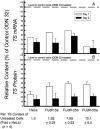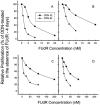Antisense-induced down-regulation of thymidylate synthase and enhanced cytotoxicity of 5-FUdR in 5-FUdR-resistant HeLa cells
- PMID: 11724749
- PMCID: PMC1573083
- DOI: 10.1038/sj.bjp.0704394
Antisense-induced down-regulation of thymidylate synthase and enhanced cytotoxicity of 5-FUdR in 5-FUdR-resistant HeLa cells
Abstract
1. Thymidylate synthase (TS) is a target for several anticancer drugs. We previously showed that an antisense oligodeoxynucleotide (ODN) directed against TS mRNA down-regulated TS protein and enhanced cytotoxicity of TS-targeting drugs [including 5-fluorodeoxyuridine (5-FUdR)] in HeLa cells. Patient tumours with increased TS expression are resistant to TS-targeting drugs. It was hypothesized that TS mRNA and consequently TS protein could be down-regulated in 5-FUdR-resistant cells that overexpress TS, sensitizing them to 5-FUdR cytotoxicity. In this study we assessed the capacity of an anti-TS antisense ODN to circumvent resistance dependent on TS overexpression. 2. Variant HeLa clones exhibiting 2 - 20 fold resistance to 5-FUdR were selected by exposing cultured cells to drug. Clones FUdR-5a, -25b, and -50a expressed TS protein levels 10 fold, 10 fold, and 17 fold higher (respectively) than parental cells. Cells were treated with antisense ODN 83 (a 2'-methoxy-ethoxylated, phosphorothioated 20-mer, complementary to a portion of the 3'-untranslated region of TS mRNA), or ODN 32 (a control ODN with the same base composition as ODN 83, but in randomized order). Twenty-four and 48 h following transfection (50-100 nM ODN, plus polycationic liposome), TS mRNA levels (by RT-PCR) and protein levels (by radiolabelled 5-FUdR-monophosphate binding) were decreased by at least 60% in ODN 83-treated cells compared with control ODN 32-treated cells. ODN 83 enhanced the cytotoxicity of 5-FUdR by up to 85% in both parental and 5-FUdR-resistant cell lines. 3. Antisense ODN can be used to down-regulate TS and attenuate drug resistance in TS-overexpressing cells.
Figures




Similar articles
-
Antisense targeting of thymidylate synthase (TS) mRNA increases TS gene transcription and TS protein: effects on human tumor cell sensitivity to TS enzyme-inhibiting drugs.Gene Expr. 2007;13(4-5):227-39. doi: 10.3727/000000006780666993. Gene Expr. 2007. PMID: 17605297 Free PMC article.
-
Antisense down-regulation of thymidylate synthase to suppress growth and enhance cytotoxicity of 5-FUdR, 5-FU and Tomudex in HeLa cells.Br J Pharmacol. 1999 Aug;127(8):1777-86. doi: 10.1038/sj.bjp.0702728. Br J Pharmacol. 1999. PMID: 10482907 Free PMC article.
-
The means to an end of tumor cell resistance to chemotherapeutic drugs targeting thymidylate synthase: shoot the messenger.Curr Drug Targets. 2002 Aug;3(4):297-309. doi: 10.2174/1389450023347605. Curr Drug Targets. 2002. PMID: 12102601 Review.
-
Thymidylate synthase mRNA expression does not predict resistance to floxuridine in a choriocarcinoma cell line.J Reprod Med. 2010 May-Jun;55(5-6):247-52. J Reprod Med. 2010. PMID: 20626181
-
Natural antisense (rTSalpha) RNA induces site-specific cleavage of thymidylate synthase mRNA.Biochim Biophys Acta. 2002 Jul 18;1587(2-3):183-93. doi: 10.1016/s0925-4439(02)00081-9. Biochim Biophys Acta. 2002. PMID: 12084460 Review.
Cited by
-
Antisense targeting of thymidylate synthase (TS) mRNA increases TS gene transcription and TS protein: effects on human tumor cell sensitivity to TS enzyme-inhibiting drugs.Gene Expr. 2007;13(4-5):227-39. doi: 10.3727/000000006780666993. Gene Expr. 2007. PMID: 17605297 Free PMC article.
-
53BP1 sensitizes breast cancer cells to 5-fluorouracil.PLoS One. 2013 Sep 6;8(9):e74928. doi: 10.1371/journal.pone.0074928. eCollection 2013. PLoS One. 2013. PMID: 24040364 Free PMC article.
-
Mechanistic evaluation of the signaling events regulating curcumin-mediated chemosensitization of breast cancer cells to 5-fluorouracil.Cell Death Dis. 2013 Feb 21;4(2):e505. doi: 10.1038/cddis.2013.26. Cell Death Dis. 2013. PMID: 23429291 Free PMC article.
-
Inhibition of BRCA2 and Thymidylate Synthase Creates Multidrug Sensitive Tumor Cells via the Induction of Combined "Complementary Lethality".Mol Ther Nucleic Acids. 2013 Mar 12;2(3):e78. doi: 10.1038/mtna.2013.7. Mol Ther Nucleic Acids. 2013. PMID: 23481354 Free PMC article.
References
-
- BENNETT C.F. Antisense oligonucleotides: is the glass half full or half empty. Biochem. Pharmacol. 1998;55:9–19. - PubMed
-
- BERG R.W., WERNER M., FERGUSON P.J., POSTENKA C., VINCENT M., KOROPATNICK D.J., BEHREND E. Tumor growth inhibition in vivo and G2/M cell cycle arrest induced by antisense oligodeoxynucleotide targeting thymidylate synthase. J. Pharmacol. Exp. Ther. 2001;298:477–484. - PubMed
-
- BERNE M.H.O., GUSTAVSSON B.G., ALMERSJO O., SPEARS P.C., FROSING R. Sequential methotrexate/5-FU: FdUMP formation and TS inhibition in a transplantable rodent colon adenocarcinoma. Cancer Chemother. Pharmacol. 1986;16:237–242. - PubMed
-
- BISHOP M.R., IVERSEN P.L., BAYEVER E., SHARP J.G., GREINER T.C., COPPLE B.L., RUDDON R., ZON G., SPINOLO J., ARNESON M., ARMITAGE J.O., KESSINGER A. Phase I trial of an antisense oligonucleotide OL(1)p53 in hematologic malignancies. J. Clin. Oncol. 1996;14:1320–1326. - PubMed
Publication types
MeSH terms
Substances
LinkOut - more resources
Full Text Sources
Other Literature Sources
Miscellaneous

